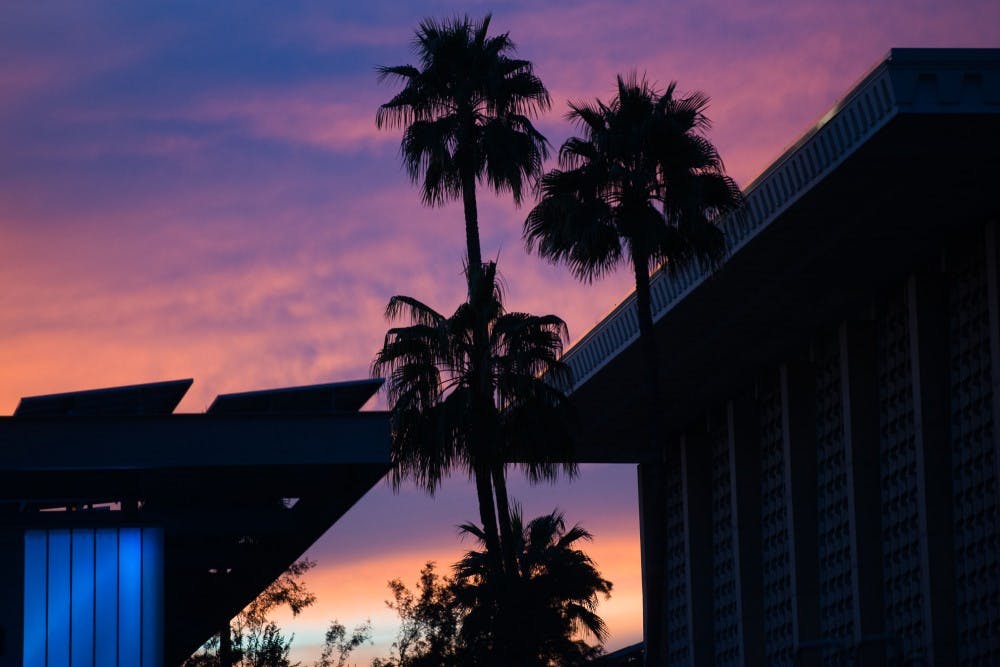While walking the Tempe campus, it’s easy to keep your nose to the ground and not look up at the rising dorms or the dilapidated buildings. Resisting the urge to keep my phone in my nose, I looked up, and all I could see were palm trees. These trees, however, have been here a lot longer than me and will keep on living long after I’ve graduated.
Barrett, the Honors College Faculty Fellow Stephanie deLusé, in her book “Arizona State University,” wrote that the history of the palm tree on the Tempe campus began during former ASU President Arthur John Matthews' reign (for whom the Matthews Center is named).
“An avid gardener, Matthews beautified the expanding campus planting countless flowers, 1,512 shrubs, 5,738 feet of hedges, and 1,478 trees of 57 kinds, including lining Normal Avenue with palm trees that grew up to be what is now the iconic Palm Walk on ASU’s campus after neighborhood streets became malls,” she wrote.
Associate Director Facilities Management Ellen Newell said, in addition to the Mexican fan palms that line Palm walk, California fan palms, date palms, Mexican blue palms, pygmy date palms, queen palms, king palms and other special varieties that are planted in courtyards also grace the Tempe campus. However, there is trouble in paradise.
“(The Palm Walk palm trees are) reaching sort of their end of life. So what we started doing, because Palm Walk is such an important feature on campus, we wanted to make sure that ... the palms don't die off,” she said. “So we’re making a plan to replace them with palms again.”
Despite the over 100 year tradition of Mexican palms on Palm Walk, there’s talk of changing it up, Newell said.
“Would we go back to the fan palms? Would we put up date palms, which have a little more shade, and we’d be able to harvest it,” she said. “We haven’t quite decided these things yet but it will be palms for sure.”
However, when there’s death, there is always life. Newell said that when she came to ASU about 12 years ago, she found that palm seedlings are our campus’ worst weeds.
“So we have our palm trees pruned once a year and it’s important that we get them pruned before they fruit, because the seeds, particularly the fan palms, are fertile, prolific,” she said.
One other unique aspect of ASU's palm trees is, of course the date palm variety. Grounds Services Program Coordinator Deborah Thirkhill said ASU was the only University that had a working arboretum and farm right on campus.
"Our date palms on campus and our date palm grove at the Polytechnic campus, we actually harvest those and sell the campus grove dates at the farmer’s market and at the bookstore," she said.
I sampled a few of the six varieties at the ASU Farmer's Market, but Thirkhill said most of the 50 varieties in ASU's possession were just for genetic breeding purposes. One of these varieties can't be found anywhere else.
"We’ve got Maresco, it’s ASU’s own variety that we developed," she said. "It was found in somebody’s backyard and we are the first to grow it. We’ve just got to turn it into USDA and tell them it’s ours. You’re not going to find Maresco anywhere else."
Related Links:
University prepares for new trees on Palm Walk
Palm Walk Runway: Rays of Sunshine
Tell the reporter your favorite flavor of date at pnorthfe@asu.edu or follow @peternorthfelt on Twitter.
Like The State Press on Facebook and follow @statepress on Twitter




